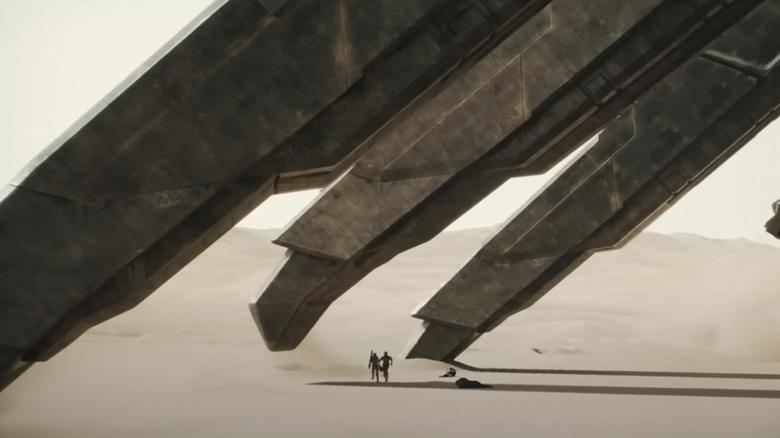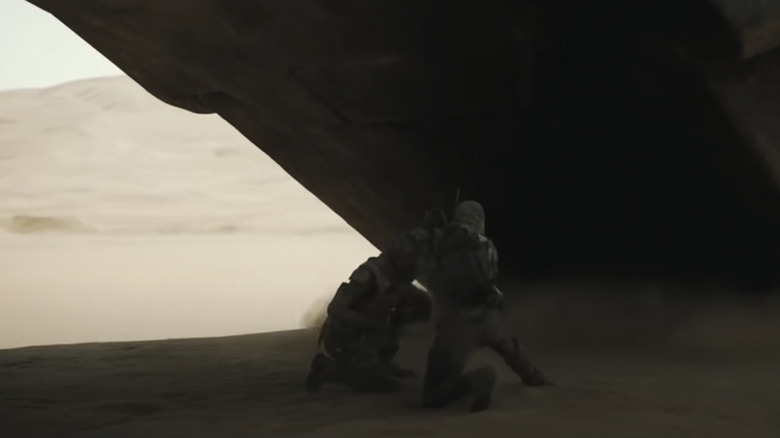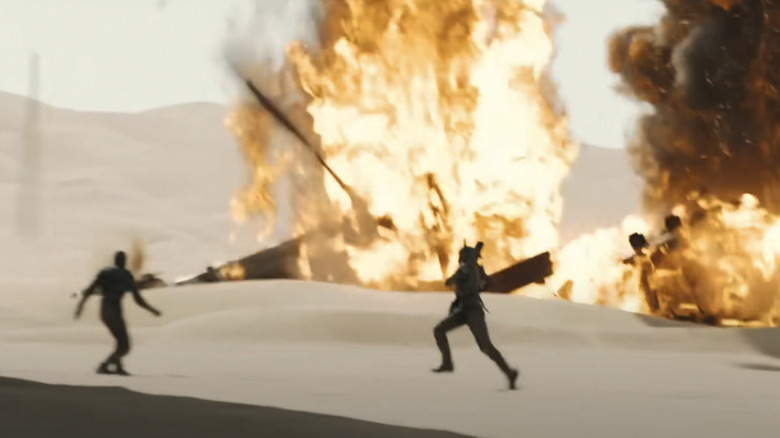Dune 2's Harkonnen Spice Harvester Required Massive Machinery For Practical Effects
As we officially hit summer, Denis Villeneuve's 2024 sequel "Dune: Part Two" remains one of the best films of 2024. The way Villeneuve managed to translate Frank Herbert's classic sci-fi novel to the big screen was nothing short of extraordinary, and as anyone who has seen it will tell you, a big part of the reason for the movie's success is because of the truly gigantic sense of scope the filmmaking team was able to bring to the story. In a cinematic landscape where some high-profile blockbuster movies and TV shows are being shot on green screens or in The Volume, the "Dune" films' reliance on using as many practical effects as possible in camera is actually palpable, as opposed to merely a publicity talking point.
In "The Art and Soul of Dune: Part Two," producer Tanya Lapointe and co-writer Stefanie Broos take readers behind the scenes of the film's production and chronicles several of the ways Villeneuve and his collaborators were able to physically achieve the staggering scale of the action scenes that take place on the fictional world of Arrakis. That includes one of the best scenes in the movie, when Paul Atredies (Timothée Chalamet) and Chani (Zendaya) participate in a daring attack on a Harkonnen spice harvester, use the giant machine's legs as a shield against an enemy ornithopter, blast the flying vehicle with a rocket launcher, and ultimately help the Fremen blow the whole harvester to smithereens.
According to the book, the film's special effects supervisor Gerd Netzer was responsible for heading up the team that engineered, tested, and operated the harvester's huge (practical) legs for the scene, which the crew lovingly referred to as "Gerd's Legs." Here's how they did it.
The Harkonnen spice harvester's legs were real (and spectacular)
"[The legs are] sixty feet wide and thirty feet high," Netzer explained in the book, saying that the harvesters are "as big as a soundstage." As for how where they were constructed, "the steel constructions for the legs were built in UAE, but the exterior cladding of the lower parts was shipped from Budapest via our art department." The top part of the legs also had fabric attached to the top to help create the shadows that would be present if the legs were actually attached to the full harvester unit. Here's a snippet from the book providing more detail:
The pair of Harkonnen harvester legs were attached to two one-hundred-ton construction excavators in order to lift them and simulate the mechanical movement Denis had envisioned for this scene. Before bringing out the main cast on set, the special effects team rehearsed over and over for accuracy as well as for safety. "I'm especially happy about the person who is driving the machine," added Gerd. "He's a construction worker who never gets nervous. I trust him 100 percent to move the leg in close distance to the cast."
Once again, there's a palpable tactility to this effect in the final film. Watching the way the light interacts with the scene, you can tell Chalamet and Zendaya are actually hiding behind a physical object instead of something that was created purely in a computer. (It's similar to the effect given by the film's practical baby sandworms.) But naturally, a collaboration with the visual effects department was necessary to achieve the desired effect of seeing the harvester in its full form. Paul Lambert, the visual effects production supervisor, spoke about expanding the size of the object digitally, as well as tracking the reality of the scene from that point on. "Once I add the computer-generated harvester, it's going to be three times higher, three times wider, and five times longer," he said. "The challenge is making sure that we set up the shots knowing that the shadows will be extended accordingly."
Dune: Part Two cinematographer Greig Fraser told /Film all about this scene
For the moments when Chani is staring down the ornithopter as she tries to blast it out of the sky, the production relied on a drone to fly on the other side of the harvester legs so her eyeline would be correct. The only problem, according to the book, was that "when the wind picked up beyond 20 miles per hour ... the drone, the shadow-maker screens, and wire cam all had to be brought down to keep the cast and crew safe."
When "Dune: Part Two" hit home video earlier this year, I had the opportunity to speak with legendary cinematographer Greig Fraser about his work on the film, and I asked him directly about this scene — specifically, the shot pictured above with Paul and Chani running in the foreground as the exploded ornithopter crashes down in the background behind them. Fraser offered excellent insights into his approach to the movie, the collaboration required between departments to pull it off, and more, so if you're a fan of the film, I highly recommend listening to the full conversation on /Film Daily.
"Dune: Part Two" is currently streaming on Max and is available on 4K, Blu-ray, and DVD.


